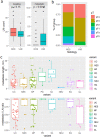Pathological reporting of cystectomy lymph nodes: a retrospective analysis of experience in Paris
- PMID: 33743060
- PMCID: PMC8571145
- DOI: 10.1007/s00345-021-03630-8
Pathological reporting of cystectomy lymph nodes: a retrospective analysis of experience in Paris
Abstract
Purpose: Pathological evaluation of pelvic lymph node (LN) dissection (PLND) is important for management of cystectomy patients. However, challenges such as unclear interobserver variability of LN counting remain. Here, we assess interobserver variability of LN measures and their clinical utility, with a focus on variant histology.
Methods: We retrieved radical cystectomy cases with PLND between 2010 and 2016 and reevaluated pathological parameters; number of total and metastatic LN, LN density (LND), length of metastatic LN and metastases, extranodal extension (ENE).
Results: We report 96 patients: median age of 71a, 34 cases pN+, 36 cases with any extent of variant histology, median follow-up 10 months. Perivesical LN were only rarely identified, but frequently metastatic (4/9). Variant histology (34 cases) frequently exhibited LN metastasis (53% of pN+ cases). Interobserver variance was poor for total LN (kappa = 0.167), excellent for positive LN (0.85) and pN staging (0.96), and mediocre for LND (0.53). ROC analysis suggests that both LND and the sum of LN metastasis length may predict outcome (AUC 0.83 and 0.75, respectively).
Conclusion: Our study confirms the notion of LND as a prognostic measure, but cautions due to strong interobserver variance of LN counts. The sum length of LN metastases could be a measure that is independent of LN counts. We find that microscopically identified perivesical LN merit particular attention. In summary, our study highlights current challenges in pathological reporting of PLND, confirms previous observations and forms a basis for further studies.
Keywords: Lymph node; Metastasis; Size of metastasis; Sum of metastasis; Urothelial carcinoma.
© 2021. The Author(s).
Conflict of interest statement
The authors declare that they have no conflict of interests.
Figures



Similar articles
-
The impact of variant histological differentiation on extranodal extension and survival in node positive bladder cancer treated with radical cystectomy.Surg Oncol. 2019 Mar;28:208-213. doi: 10.1016/j.suronc.2019.01.008. Epub 2019 Jan 30. Surg Oncol. 2019. PMID: 30851902
-
Radical cystectomy and extended pelvic lymphadenectomy: survival of patients with lymph node metastasis above the bifurcation of the common iliac vessels treated with surgery only.J Urol. 2007 Oct;178(4 Pt 1):1218-23; discussion 1223-4. doi: 10.1016/j.juro.2007.05.160. Epub 2007 Aug 14. J Urol. 2007. PMID: 17698113
-
Lymph node yield in node-negative patients predicts cancer specific survival following radical cystectomy for transitional cell carcinoma.Investig Clin Urol. 2017 Nov;58(6):416-422. doi: 10.4111/icu.2017.58.6.416. Epub 2017 Oct 23. Investig Clin Urol. 2017. PMID: 29124240 Free PMC article.
-
Pelvic lymph node dissection during radical cystectomy for muscle-invasive bladder cancer.Nat Rev Urol. 2018 Nov;15(11):686-692. doi: 10.1038/s41585-018-0066-1. Nat Rev Urol. 2018. PMID: 30104615 Review.
-
Lymph node dissection in bladder cancer. Impact on staging and prognosis.Dan Med J. 2012 Dec;59(12):B4559. Dan Med J. 2012. PMID: 23290294 Review.
Cited by
-
Multi-Center Assessment of Lymph-Node Density and Nodal-Stage to Predict Disease-Specific Survival in Patients with Bladder Cancer Treated by Radical Cystectomy.Bladder Cancer. 2024 Jun 18;10(2):119-132. doi: 10.3233/BLC-230086. eCollection 2024. Bladder Cancer. 2024. PMID: 39131875 Free PMC article.
References
-
- Compérat E, Srigley JR, Brimo F, et al. Dataset for the reporting of carcinoma of the bladder-cystectomy, cystoprostatectomy and diverticulectomy specimens: recommendations from the International Collaboration on Cancer Reporting (ICCR) Virchows Arch Int J Pathol. 2020;476:521–534. doi: 10.1007/s00428-019-02727-1. - DOI - PubMed
MeSH terms
LinkOut - more resources
Full Text Sources
Other Literature Sources
Medical

